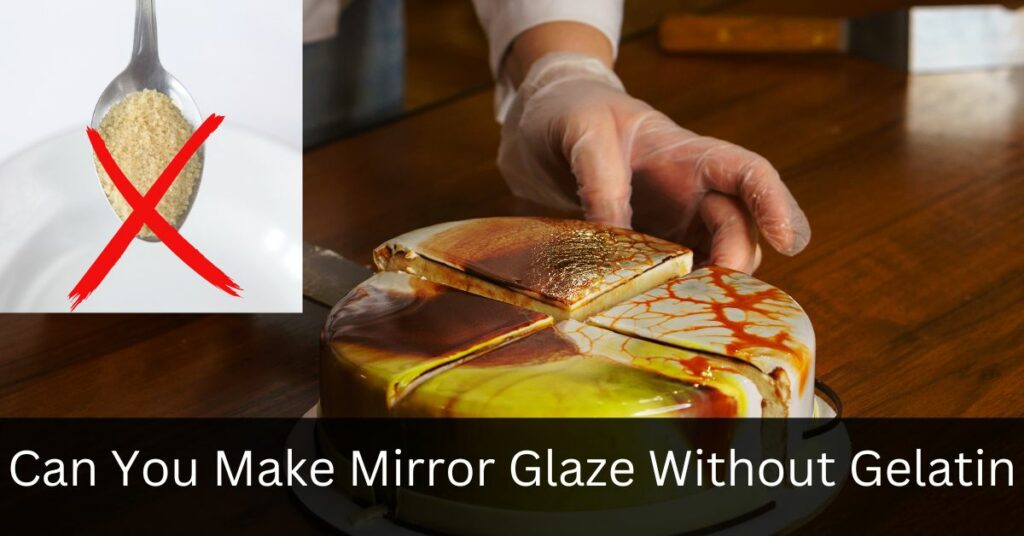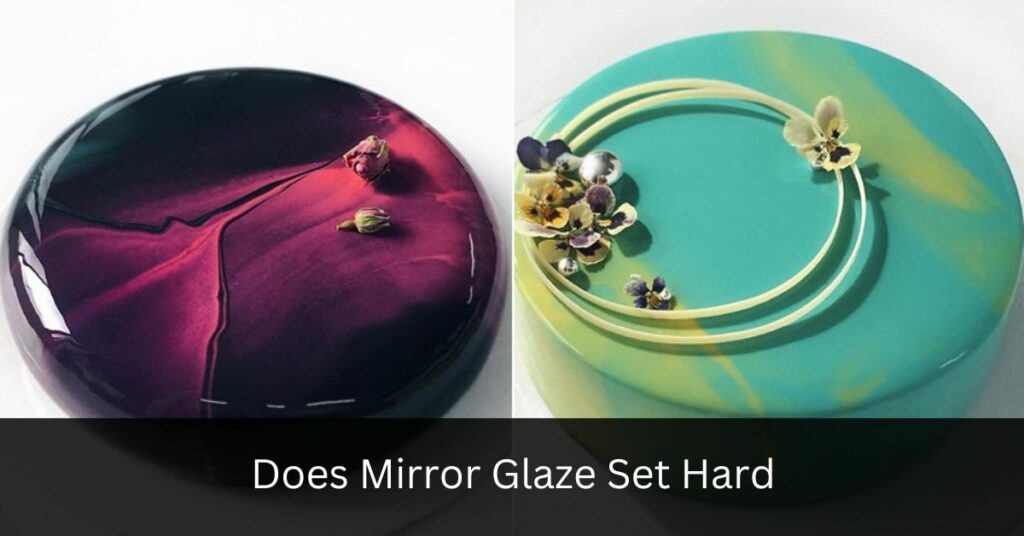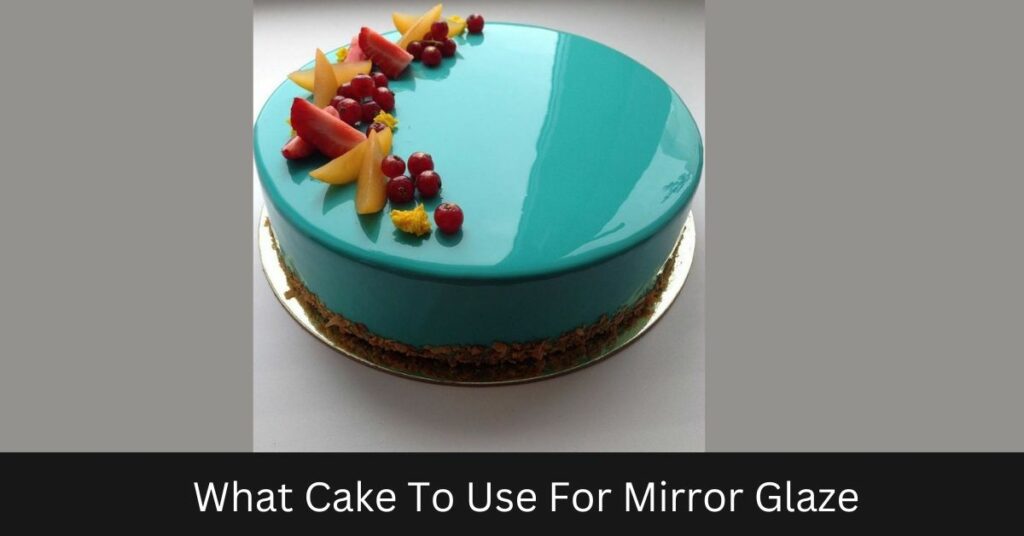Mirror glaze is a beautiful and delicious way to top off cakes, pastries, and desserts. It adds a glossy shine that’s almost too pretty to eat – but we all can’t resist! But what if you don’t have gelatin on hand? Can you still make mirror glaze without it?
It turns out the answer is yes! You can create an equally stunning mirror glaze without using any gelatin at all, even though this ingredient has been traditionally used in most recipes up until now. In fact, there are several different ways to make a vegan or vegetarian alternative that will give your dessert just as much flair.
So let’s take a look at the various methods available for making your own homemade mirror glaze – no gelatin required! Whether you’re looking for something quick and easy, or something more complex with unique flavors, we’ve got you covered with all the options. Read on to learn how to craft perfect mirror glazes for any occasion.
1. What Is Mirror Glaze?
Mirror glaze is a type of icing that results in a glossy and reflective finish, much like a mirror. It’s easy to see why this technique has become increasingly popular with bakers looking to create stunning cakes and desserts. It’s no wonder it’s often referred to as ‘liquid glass’!
Typically made from chocolate ganache or white chocolate mixed with various ingredients such as condensed milk, butter, oil and cream, the key ingredient for achieving the high-shine effect is gelatin which gives the mixture its structure and stability. Without it, creating an even spread of glaze on a cake would be difficult if not impossible.
Fortunately though, there are several alternative recipes out there enabling you to make mirror glaze without using any gelatin at all. Depending on your preference, these alternatives range from basic mixtures to more complex concoctions involving different types of sugars or other thickeners – each one offering up their own unique look and flavor possibilities.
2. What Ingredients Are Used In Mirror Glaze?
Mirror glaze is a mesmerizing and eye-catching dessert topping that has recently become popular on social media. It’s glossy, smooth surface makes it look like the perfect reflection of a mirror! But what does one need to make this shiny masterpiece? What ingredients are used for this tantalizing treat? Let’s find out!
Mirror glaze typically consists of sugar syrup, condensed milk, cocoa powder, butter or margarine, and gelatin. Sugar syrup is made by dissolving sugar in hot water until it reaches a thick consistency while condensed milk provides sweetness and creaminess. Cocoa powder adds chocolatey flavor as well as an attractive dark hue to the mixture. Butter or margarine helps give the glaze its silky texture while gelatin acts as a stabilizer which prevents clumping when refrigerated.
Now that we know what goes into making mirror glaze, let’s explore further how exactly gelatin works within it…
3. What Is Gelatin And How Does It Work In Mirror Glaze?
Mirror glaze is a dessert topping with an almost magical effect. It’s a glossy, transparent glaze that makes cakes look like works of art—almost too perfect to eat! But what’s the secret behind this sugary sorcery? The answer lies in one key ingredient: gelatin.
Gelatin is a colorless and flavorless protein derived from collagen, which is found in animal tissues such as skin, tendons, and bones. When dissolved in hot liquid, it forms a gel-like structure when cooled. This gel-like property allows bakers to create the signature mirror glaze for desserts; its texture holds air bubbles to give them their glossy finish.
Using gelatin also gives more control over the consistency of the glaze. Different amounts of gelatin can be used to achieve different textures—from thick and fluffy mousses to thin and shiny icings. With some practice and experimentation, you’ll soon have your own custom recipe perfected that creates impeccable masterpieces every time!
4. What Substitutes For Gelatin Can Be Used In Mirror Glaze?
For those looking to make mirror glaze without the use of gelatin, there are several alternatives. Many recipes call for agar-agar as a substitute, which is derived from seaweed and can be found in most grocery stores. Agar-agar has similar properties to gelatin when it comes to its gelling power, however it must be boiled longer than gelatin in order to gain maximum effect. Additionally, some people have had success with kappa carrageenan, a natural thickener made from red algae that gives a glossy finish to cakes and desserts.
If you don’t want to work with either of these ingredients, then xantham gum could also be used as an alternative. This ingredient is often used in gluten-free baking and food production due to its ability to act as a stabilizing agent and bind together certain components of batter or doughs. Though it does not provide the same glossy sheen as other options, it will still help stabilize your glaze mixture so that it sets correctly.
Finally, if you’re looking for something vegan-friendly and easy to find at any store, consider using pectin instead of gelatin or agar-agar. Pectin is extracted from citrus fruits such as oranges and lemons and helps thicken sauces while providing extra sweetness too – perfect for adding into your mirror glaze! With all this information on hand, you should now have no trouble making delicious mirror glazes without the need for gelatin.
5. How To Make Mirror Glaze Without Gelatin
Mirror glaze is a popular dessert that looks like a perfect reflection of glass. It’s commonly used to top cakes and tarts, giving them an elegant finishing touch. Creating this glossy texture requires the use of gelatin – something many people don’t have access to or are simply looking for alternatives to. Fortunately, there are several ways you can make mirror glaze without gelatin.
Just like how lighting up a room takes away the darkness and reveals what lies beneath, using substitutes instead of gelatin in your mirror glaze recipe lets you discover new flavors while maintaining its beautiful reflective effect. Agar-agar powder is one such substitute that works well as it has similar gelling properties to gelatin when mixed with water or liquid ingredients. It also adds a subtle flavor which complements the sweetness of desserts like cakes and tarts perfectly! Additionally, fruit pectin can be used as another alternative if agar-agar isn’t available – all you need to do is mix it with sugar syrup before adding it into the mixture.
Making mirror glaze without gelatin does require patience and precision but with enough practice, it’s possible to achieve stunning results every time! To help ensure success on your next attempt, here are some useful tips…
6. Tips For Making Mirror Glaze Without Gelatin
Creating the perfect mirror glaze can seem like a daunting task. It’s almost like mastering an art form, but with some patience and practice, you’ll be well on your way to creating something truly magical. Making mirror glaze without gelatin is no different—with just a few extra steps, you can transform any cake into a masterpiece.
When making mirror glaze without gelatin, there are several tips worth following for best results. First, make sure that all of your ingredients are cold before beginning. If they’re not cold enough, it will prevent the mixture from thickening properly and create a watery texture in the finished product. Additionally, try using agar-agar or xanthan gum as alternatives to gelatin when thickening the glaze; both have properties similar to those of gelatin, yet won’t change its flavor profile. Finally, don’t forget to sift your powdered sugar prior to combining it with other ingredients—this helps avoid clumps that may otherwise ruin the consistency of your mirror glaze.
With these essential tips in mind, you should be ready to get started on crafting beautiful creations with mirror glaze! All that remains now is troubleshooting any potential issues that might arise during preparation so you can easily fix them along the way and end up with flawless results every time.
7. Troubleshooting Mirror Glaze Without Gelatin
Mirror glaze without gelatin? That’s like packing a suitcase for an adventure and forgetting your socks; it just doesn’t feel quite right. But don’t worry – with enough patience and practice, you can still get the glossy finish that mirror glaze is known for! Here are some troubleshooting tips to help you out.
First, be sure to use good quality ingredients in your recipe. Low-quality ones will affect the flavor of your glaze and make it less likely to gel correctly. You’ll also want to pay attention to how long you’re mixing or whisking the mixture; if it gets too thick, the finished product won’t have that nice shine. And finally, try not to overheat the mixture; this could also cause problems with its set time.
When making mirror glaze without gelatin, there are bound to be some hiccups along the way – but these simple steps should help ensure that yours turns out beautiful every single time! With a little bit of extra effort, you can create something wonderful even when working around tricky ingredients like gelatin. All it takes is a little trial and error until you find what works best for you!
Frequently Asked Questions
Is Mirror Glaze Safe To Eat?
Mirror glaze is a sweet, beautiful and mesmerizing topping for cakes that can light up any party or celebration. It gives the cake an aesthetic appeal and also makes it look mouthwatering! But have you ever wondered if mirror glaze is safe to eat?
Upon closer inspection, one finds out that gelatin is used as a thickening agent in many recipes of making mirror glaze. However, not all recipes include this ingredient; some use alternative ingredients such as agar-agar instead. Gelatin is essentially made from animal bones so it may be unsuitable for vegetarians or those with religious dietary restrictions. Thus, when considering whether mirror glaze without gelatin is safe to eat, its suitability should firstly be determined by the recipe’s ingredients.
The second factor to consider when determining safety of consuming mirror glaze without gelatin is food hygiene standards. For instance, make sure that all utensils are washed properly before using them in preparation and that the kitchen surfaces where you work are kept clean at all times. Furthermore, avoid cross contamination between raw and cooked foods – wear gloves while working with both types of food items and wash your hands frequently throughout cooking process. Taking these steps will help ensure everyone’s safety when eating mirror glaze.
To sum up then, yes it is possible to create a delicious and eye catching showstopper of a cake with mirror glaze without including gelatin in the recipe – just check what other ingredients are being used instead and follow basic hygiene rules during preparation.
Is Mirror Glaze Difficult To Make?
Mirror glaze is not your average cake topping! It’s a complex, captivating craft that will leave you in awe. Preparing it requires dedication and skill – the kind of expertise that few possess. Just one false move can spell disaster for this delicate dessert decoration. So when it comes to making mirror glaze, is it really as hard as they say?
The truth is that mirror glaze isn’t something anyone can whip up on a whim; there’s no denying its difficulty level. You’ll need patience and an eye for detail if you want your creation to look perfect. Even experienced bakers have been known to struggle with this sugary spectacle! But don’t be discouraged: With practice, even beginners can learn how to make stunningly smooth mirror glazes.
Making a show-stopping slice of cake topped off with luscious mirror glaze takes time and effort – but the results are worth every minute spent in the kitchen! Whether you’re creating a dessert masterpiece or simply trying out a new recipe, mastering the art of mirror glazing could take some trial and error. However, once you’ve perfected your technique, you just might find yourself becoming a pro at preparing these glossy treats.
How Long Will Mirror Glaze Stay Fresh?
Mirror glaze – something that sounds so delicious and yet, how long will it stay fresh? Irony of the situation is that despite its deliciousness, you can’t keep eating it for days!
Well if you are wondering about the longevity of mirror glaze, then here’s what you need to know. It depends on a few things like, how it was stored before use and after use. In general though, the shelf life of mirror glaze is quite short- 1 or 2 days at most. So if you have made some ahead of time or received an advance order than best store in an air tight container and refrigerate as soon as possible.
Moreover, be aware that even when stored correctly there may still be signs of deterioration such as cracking or discoloration over time. This means you should plan accordingly and make enough only for immediate consumption.
TIP: Make sure to check your ingredients carefully while making mirror glaze especially gelatin which affects its stability and storage time significantly.
Does Mirror Glaze Need To Be Refrigerated?
Mirror glaze is like a shimmery blanket of artistry, covering cakes and other desserts with its glossy sheen. But does this captivating glaze require refrigeration to stay fresh?
The answer will depend on several variables such as the environment in which the cake or dessert is stored and the ingredients used in making the mirror glaze. Most recipes call for gelatin, but there are also alternative options such as agar-agar that don’t need to be kept cold. If you choose to use gelatin, it’s important to store your creations in an airtight container until ready to serve; otherwise, they should be kept refrigerated at all times. On the other hand, if you opt for an alternative option like agar-agar or carrageenan, then these can usually remain at room temperature without any issue.
No matter what ingredients you decide to work with when crafting your own personalised version of mirror glaze, one thing remains true: keeping it away from direct sunlight and heat sources will help prolong its shelf life and ensure it stays looking beautiful for longer.
Is Mirror Glaze Suitable For Vegan Diets?
Mirror glaze is a beautiful, glossy topping for cakes and desserts that looks like liquid glass. But does it fit into a vegan diet? In short, the answer is yes! Mirror glaze doesn’t contain any animal products as one of its ingredients, so vegans can still enjoy this treat without compromising their dietary principles.
The most common form of mirror glaze contains gelatin, but there are ways to make it without using animal-based products at all. Agar agar or pectin are two great substitutes that can be used in place of gelatin in order to create an equally delicious result. Plus, they’re both derived from plants, making them suitable for anyone looking for a vegan alternative.
It’s important to note that even if you make your own mirror glaze with plant-based alternatives rather than gelatin, it will still need to be refrigerated once made in order to ensure that it stays fresh for when you want to use it. However, if stored correctly, this gorgeous decorative icing should keep nicely for up to five days – providing you with plenty of time to show off your creations!
Conclusion
In conclusion, Mirror Glaze can be a great addition to any dessert. It is not only safe to eat, but also easy and quick to make. With the right ingredients, it will stay fresh for days without needing refrigeration and can even be made vegan-friendly with some simple substitutions.
But can you make Mirror Glaze without gelatin? Absolutely! By replacing the traditional gelatin in the recipe with agar powder or another type of vegetable-based alternative, vegans and vegetarians alike can still enjoy this delicious treat. The key is finding an ingredient that provides similar thickening properties as gelatin so that your glaze sets correctly.
Mirror Glaze may seem intimidating at first, but once you understand how to achieve its signature glossy finish without using animal products, you’ll find yourself creating all sorts of dazzling desserts. So why not give it a try? After all, what’s stopping you from making something truly magical?



